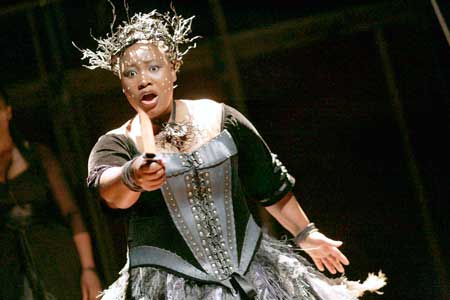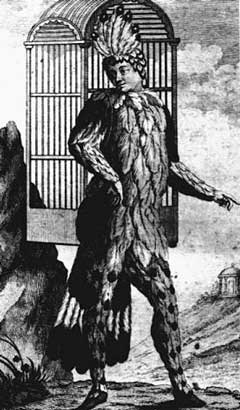Opera (1791)
by Wolfgang Amadeus Mozart
Libretto by Emanuel Schikaneder
Created by Isango Ensemble
Adapted and directed by Mark Dornford-May
Music arranged by Pauline Malefane and Mandisi Dyantyis
Presented by Eric Abraham and ArtsEmerson
Emerson/Cutler Majestic Theater
Boston, MA
October 21-26, 2014
With Noluthando Boqwana, Mandisi Dyantyis, Thobile Dyasi, Ayanda Eleki, Zamile Gantana, Nontsusa Louw, Sifiso Lupuzi, Pauline Malefane, Bongiwe Mapassa, Zanele Mbatha, Syasanga Mbuyazwe, Sinethesmba Mdena, Zebulon Mmusi, Mhlekazi (Whawha) Mosiea, Zoleka Mpotsha, Siyanda Mcobo, Cikizwa Ndamase, Busisiwe Ngejane, Zolina Ngejane, Sonwabo Ntshata, Tukela Pepeteka, Luvo Rasemeni, Masakane Sotayisi, Ayanda Tikolo

in “The Magic Flute”
Photo: Keith Pattison
Courtesy of ArtsEmerson
The story is the same as in Mozart’s opera: Tamino, a young prince, captivated by the lovely Pamina, is taken in by Pamina’s mother, the Queen of the Night, and commissioned by her to kill Sarastro, who she says is evil. Well, saying isn’t everything: Sarastro turns out, flipside, to actually be the noble one. Tamino and his sidekick Papageno go through all sorts of trials to win the day, and finally Tamino and Pamina, passing through the tests of water and fire, get their relationship together under Sarastro’s guidance. Sarastro tries to make peace with the Queen of the Night, but she’ll have none of it, setting the whole scene for a sequel which, alas, never happened.
What a gas this production is. It really is Mozart, through and through, but from the downbeat it is just wild and fun. As the eight marimbas, arrayed on both sides of the stage, started to play the overture in incredible detail and with wonderful energy, I really just wanted to pop out of my seat and dance. It was really something else. And nobody, throughout the whole two hours of the opera, uses sheet music!

in “The Magic Flute”
Photo: Keith Pattison
Courtesy of ArtsEmerson
The cast and the marimba orchestra rotate, so you find a member of the recent vocal spirit trio all of a sudden rocking out on the treble marimba with incredible virtuosity. And when these guys do rock out, boy do they let go. It is just wonderful to see the marimba players bouncing and weaving to the melodies of opera. How very cool!
There are plenty of moments when the cast dances and weaves and takes on a decidedly tribal angle with the basic themes of the opera.
The dancing, the marimbas, the whole setup is really top notch.

in “The Magic Flute”
The singing generally is the weaker part of the production, though everybody sings in tune and has the melodies down. The size and training of the voices, by and large, is somewhat limited, though, in the context of the larger significance of the show it does not matter. The Queen of the Night pulls off her coloratura arias perfectly well, though one would not call this premier quality opera singing. At various points, I wished that the production had chosen to use more natural, African-style, singing voices, but I suppose that could be a rather difficult challenge with the Mozart themes. Though there were some lovely moments of singing, by and large,this was not the central strength of the production.
What a great idea to take a classic Western opera and adapt it with indigenous instrumentation and dance, a unique and rousing combination.
– BADMan
Leave a Reply